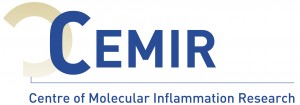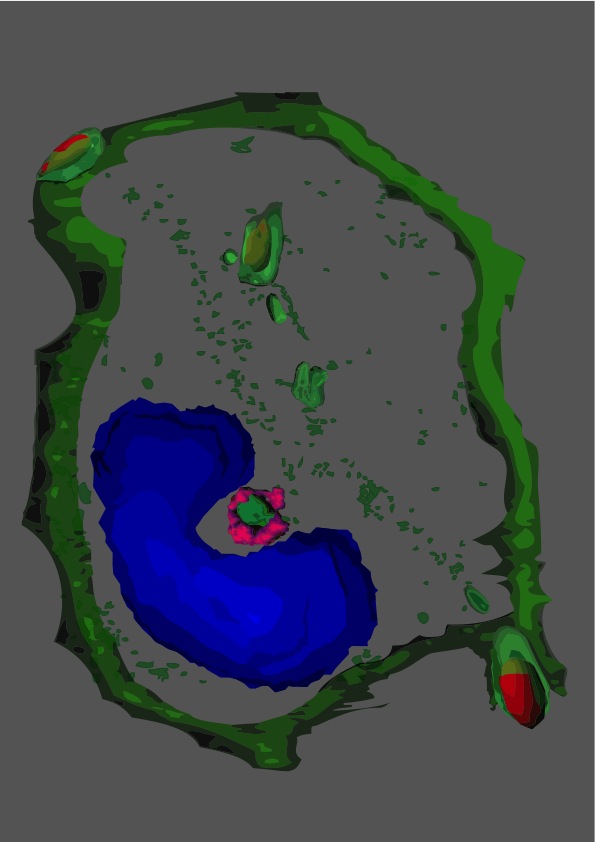 Blogger: Terje Espevik, Director of CEMIR
Blogger: Terje Espevik, Director of CEMIR
 The official opening of the Norwegian University of Science and Technology’s four new centres of excellence (CoE) will take place on Monday 10 June. CEMIR, the Centre of Molecular Inflammation Research, is one of these new centres. CEMIR researchers will study new mechanisms that set off inflammatory responses. We hope this will provide us with information that could help in the development of new treatment methods and the diagnosis of diseases in which inflammation plays a crucial role. You can read more about CEMIR at http://www.ntnu.edu/cemir
The official opening of the Norwegian University of Science and Technology’s four new centres of excellence (CoE) will take place on Monday 10 June. CEMIR, the Centre of Molecular Inflammation Research, is one of these new centres. CEMIR researchers will study new mechanisms that set off inflammatory responses. We hope this will provide us with information that could help in the development of new treatment methods and the diagnosis of diseases in which inflammation plays a crucial role. You can read more about CEMIR at http://www.ntnu.edu/cemir
In June there will be more blogs from CEMIR researchers.
When an infection or injury triggers our immune system, it causes an inflammation in the affected area. This field has seen rapid development over the past 15 years. We now know a lot about the sensors that initiate inflammation and the importance they have in our defence against microbes, as well as the significance of this reaction in chronic diseases.
We live in a world with countless microorganisms, some of which can cause serious infections. Many of these microorganisms can cause infectious diseases that are among the main causes of death and disability in the world.
Approximately 13.7 million people die each year of infectious diseases, of which respiratory infections are the largest cause of mortality. The human immune system is tailored to handle disease-causing viruses, bacteria, fungi and parasites, but sometimes this system reacts too weakly or too strongly, which can cause disease. The immune system must also eliminate molecules from the body that have been modified or altered in some way.
When an infection or injury triggers our immune system, it causes an inflammation in the affected area. This field has seen rapid development over the past 15 years. We now know a lot about the sensors that initiate inflammation and the importance they have in our defence against microbes, as well as the significance of this reaction in chronic diseases.

The image shows an immune cell (macrophage) that is about to engulf two bacteria. The bacteria are shown in red. The sensor the macrophage uses to initiate the inflammatory response is shown in green. The image shows how the sensors assemble around the bacterium. The cell nucleus is shown in blue. The image was taken using a confocal microscope. Photo: Marie Helmet Seth Aune.
Inflammation has a long and colourful history that is closely connected to the history of wars and subsequent injuries and infections. It was the Roman physician Cornelius Celsus (30 BC – 38 AD) who described the classic symptoms of inflammation: heat, pain, redness and swelling. Somewhat later, functional impairment was added as a symptom.
These classic symptoms are the result of the activation of endothelial cells that line the blood vessels near the site of injury, which causes plasma and blood cells to flow into the tissue around the injured area. Inflammation is an absolutely essential mechanism that the body uses to remove harmful substances and to start the healing process. The body regulates this process carefully and it is generally a transient event. But if the reaction is too powerful it can result in blood poisoning (sepsis). If the body is unable to remove harmful substances, it can lead to the chronic inflammation that is seen in diseases such as arthritis, arteriosclerosis and cancer.
A balanced inflammatory response is essential to maintaining the body’s normal state. Normally, the body’s sensors detect infection at an early stage and initiate healing as soon as the infection is gone. An inflammatory response should be acute and short-lived, and should not be sustained over a long period. A long-lasting response is considered chronic inflammation, which is associated with a number of different kinds of diseases, including autoimmune diseases such as rheumatoid arthritis.
An inflammatory response should be acute and short-lived, and should not be sustained over a long period. A long-lasting response is considered chronic inflammation, which is associated with a number of different kinds of diseases, including autoimmune diseases such as rheumatoid arthritis.
Throughout the 1990s, researchers noticed that more and seemingly diverse diseases were characterized by an accumulation of immune cells at the site of the disease. Researchers first discovered this in arteriosclerosis, and eventually in other conditions such as obesity, type 2 diabetes, Alzheimer’s disease and cancer. These findings have created a great deal of interest in inflammation and the mechanisms and sensors that are activated by chronic conditions.
What will be the key to CEMIR’s success?
The award of CoE status is very prestigious and involves long-term funding for research. But with this status comes a commitment. We will deliver research of outstanding quality over the next 10 years. That means we must plan a sound strategy for success, which must include many important elements.
CEMIR has an original and ambitious research project that focuses on the molecular mechanisms underlying the first phase of the inflammatory response. We believe that having a research focus on this first phase is important, since it means our results should be applicable to the many seemingly different kinds of inflammatory diseases.
CEMIR has an original and ambitious research project that focuses on the molecular mechanisms underlying the first phase of the inflammatory response.
An ambitious research project also requires very good researchers, research groups and access to advanced methods and technology. An important strategic element here is that we have assembled five interdisciplinary research groups locally that have backgrounds in cell and molecular biology and clinical medicine. The centre will also benefit from having access to the six core facilities that the Faculty of Medicine has created. This enables the basic research that we do to get closer to patients.
However, Trondheim and NTNU are a bit off the beaten track, so we also need a strategy for collaborating with researchers from other good and prestigious research communities both nationally and internationally. We have addressed this by recruiting six outstanding researchers (three from the USA, one from Germany and two from Oslo) to fill professor II positions at the centre. These individuals will organize three PhD courses for the centre, and will be more tightly involved with the centre by supervising our PhD and postdoctoral candidates, who will spend extended periods in their laboratories.
CEMIR is now in a very exciting development phase with many new employees. Towards the end of 2013, CEMIR will be established at the The Knowledge Center (Kunnskapssenteret), where researchers will have access to new laboratories and offices.
Follow this blog in June – there will be more stories from the researchers at CEMIR.
